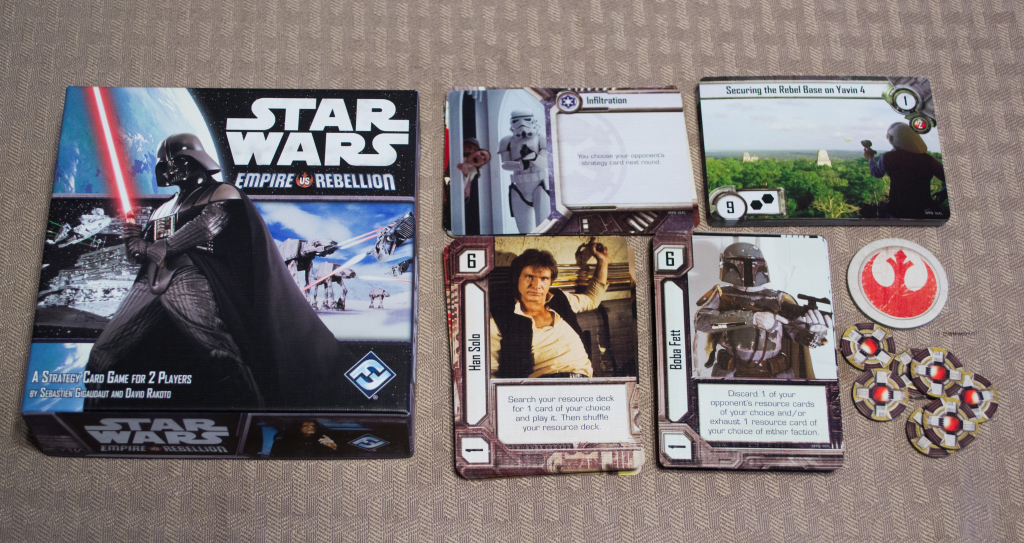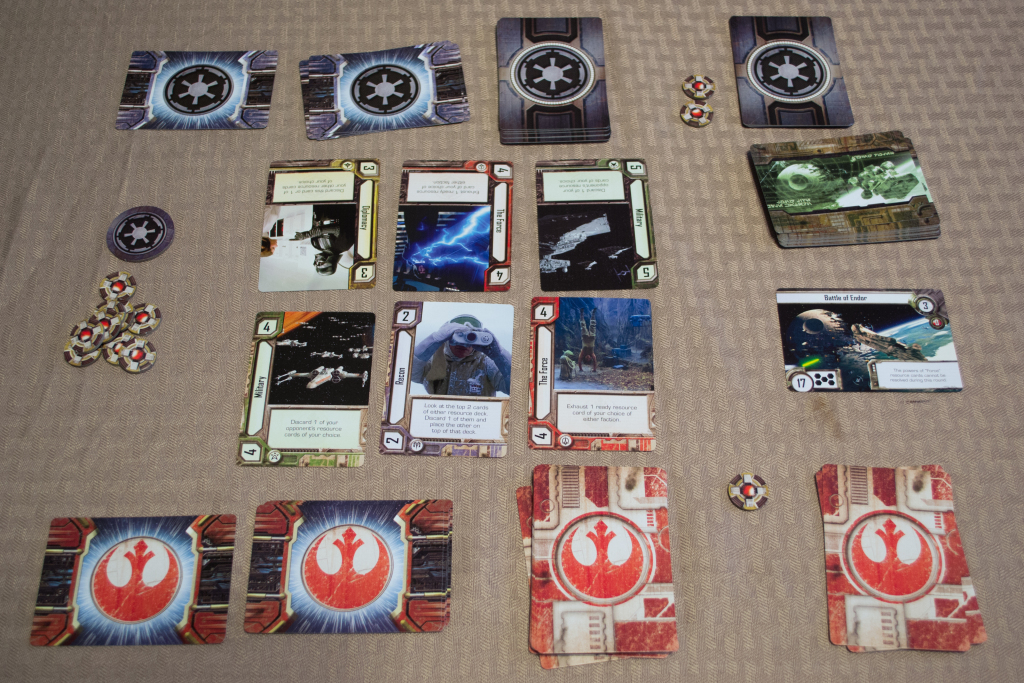“Star Wars: Empire vs. Rebellion” is a two player card game that spans the course of the original trilogy (Episodes IV through VI). I was admittedly a little skeptical when this first released because the folks at Fantasy Flight Games have already provided us with “Star Wars: The Card Game“, which basically offers the same thing. After giving this game a go, I came to realize that both games are alike and different in a number of ways. Before I get ahead of myself, let’s take a brief look at what came in the box and how the game is played.
Components
Cards – The game includes 24 Rebel Resource Cards, 24 Imperial Resource Cards, 5 Rebel Strategy Cards, 5 Imperial Strategy Cards, and 24 Event Cards.
Tokens – The game includes 1 Balance Token and 16 Influence Tokens.
Setup & Gameplay
Players will shuffle the event deck and select a faction, receiving the resource & strategy cards from the faction they picked. Once that’s done, they’ll choose four character cards from the resource deck and set aside any other character cards that might be present (these are placed into a “reserve” deck). Each player shuffles their four chosen character cards along with the rest of the resource cards and places the deck face down in their play area. The strategy cards are likewise shuffled and placed face down in the play area. Players receive two influence tokens each and the balance token is flipped to determine which side starts as the dominant faction.
The goal of this game is for players to attempt to win event cards, each of which lists a victory point value. The first player to reach seven or more victory points wins the game.
The game is broken up into a series of rounds. A typical round is broken up as follows:
1. Planning Phase – Players will reveal the next event card and secretly choose one of their unused strategy cards, placing it facedown in their play area.
2. Struggle Phase – Players will compete, using their resource cards, in an attempt to win the event card. They’ll be able to (in turn) play resource cards, use a power on an existing resource card by exhausting (tapping) it, spend influence tokens to ready (untap) a resource card, and pass. This phase ends when both players pass in succession.
3. Dominance Phase – Players will reveal their strategy cards and determine victory. Each resource card has a tapped and untapped value (some tapped values are lower), so it’s important for players to factor this in when using abilities during the struggle phase. The player with the greatest resource value total without exceeding the value listed on the event card wins it. The winner not only gains the event card’s effect (if any), but also receives a number of influence tokens equal to the influence value listed on the card.
At the round’s end, players reshuffle their resource deck to create a new one, however the strategy cards are discarded and can’t be used again (unless both players run out, in which case they can retrieve all five and reuse the deck). Rounds continue until one player achieves victory.
The above doesn’t cover all of the rules found in the manual, but should give you the general idea as to how the game is played. For more information, you can find the rulebook here:
The Review
I’ll say this, “Star Wars: Empire vs. Rebellion” is much easier than the aforementioned “Star Wars: The Card Game”. “SW: TCG” allows players to attack directly, whether it be at an enemy unit or objective card. Here, players are limited in that regard, though some special abilities do affect the other player when used. “SW: EvR” reminded me a bit of “Smash Up” as the general premise is the same: lay down a series of cards with specific resource/power values in an attempt to win the objective card. “SW: TCG” is easily much more involved in that there’s a lot more to consider from round to round, what with the earning of resource tokens, the balance of the force mechanic, and the “edge” effect employed during combat (just to name a few examples). “SW: EvR” also borrows elements from “Blackjack” and “War” (“War” has many variants) in that you can “bust” if you go over a certain point limit.
That’s not to say that “SW: EvR” isn’t enjoyable, in fact I prefer playing easier games at times due to how busy I can get. I really enjoy playing the “Star Wars: X-Wing Miniatures Game” and “SW: TCG”, but both require a bit of commitment when it comes to setting up and cleaning up. Both games feature a ton of expansions and if you own them, you’ll often be sorting through your collection for hours trying to come up with the best combinations for your next bout. “SW: EvR” keeps it simple with only twenty-four resource cards per side and most act the same way as their faction counterpart. This can be good or bad, depending on what kind of mood you’re in and how much free time you have at that particular moment. I also noticed that the card art was different this time around, as “SW: EvR” opted to use movie stills whereas “SW:TCG” uses hand drawn art. Again, the reactions on this will vary from individual to individual…I personally didn’t care either way as both games look great and feel thematic.
All in all, this game met my expectations and I felt that twelve bucks was a fair price to ask for the content it delivered. It didn’t “wow” me in any particular way, but it did enough to justify my purchase. A sixty minute playing time might be a bit of an overestimate as experienced players will no doubt be able to plow through a game in half that time as you’re only playing to seven victory points. Games, on average, take anywhere from three to five rounds as most event cards are worth one, two, or three victory points. With that being said, I don’t see why you couldn’t play to ten or even fifteen victory points if you wanted a more epic game. Bottom line: “Star Wars: Empire vs. Rebellion” is worth a purchase assuming you are indeed a Star Wars fan and don’t mind playing lighter card games.
Final Verdict: 7/10
—
—


